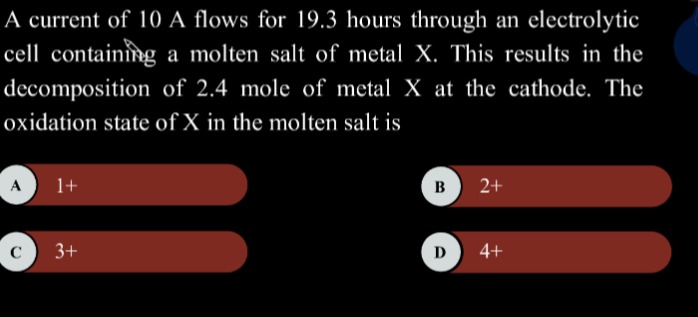Question
Question: A current of 10 A flows for 19.3 hours through an electrolytic cell containing a molten salt of meta...
A current of 10 A flows for 19.3 hours through an electrolytic cell containing a molten salt of metal X. This results in the decomposition of 2.4 mole of metal X at the cathode. The oxidation state of X in the molten salt is

1+
2+
3+
4+
3+
Solution
The deposition of a metal at the cathode during electrolysis follows Faraday's laws of electrolysis. According to Faraday's first law, the mass of a substance deposited is proportional to the charge passed. According to Faraday's second law, when the same quantity of electricity is passed through different electrolytes, the masses of the substances deposited are proportional to their equivalent weights.
The reduction reaction at the cathode is Xn++ne−→X, where n is the oxidation state of metal X in the molten salt. This means that n moles of electrons are required to deposit 1 mole of metal X.
The total charge q passed through the electrolytic cell is given by the product of the current I and the time t. Given I=10 A and t=19.3 hours. First, convert the time to seconds: t=19.3 hours×60 minutes/hour×60 seconds/minute=19.3×3600 s=69480 s.
Now, calculate the total charge passed: q=I×t=10 A×69480 s=694800 C.
The number of moles of electrons passed is given by q/F, where F is Faraday's constant (F≈96500 C/mol). Number of moles of electrons =Fq=96500 C/mol694800 C.
From the reduction reaction Xn++ne−→X, n moles of electrons deposit 1 mole of X. Therefore, 1 mole of electrons deposits 1/n moles of X. The total number of moles of X deposited, N, is equal to the total number of moles of electrons passed divided by n. N=nNumber of moles of electrons=nq/F=nFq.
We are given that N=2.4 moles of metal X are deposited. So, 2.4=n×96500694800.
Now, we can solve for n, the oxidation state of X: n=2.4×96500694800. n=231600694800. n=23166948.
Performing the division: 6948÷2316=3.
So, the oxidation state of X in the molten salt is +3.
